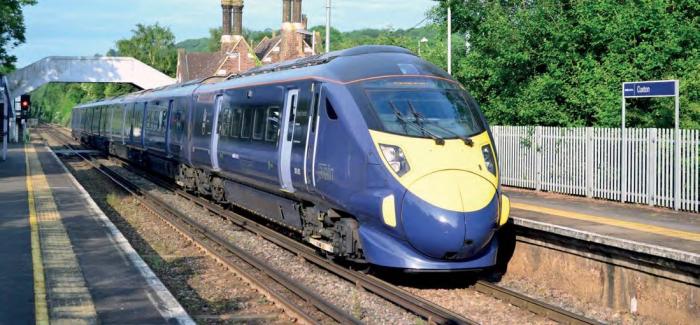
EXTENDING PLATFORMS at Charing Cross station across the Thames and turning the Metropolitan reversible line linking Cannon Street and Blackfriars into a siding are among infrastructure options outlined in Network Rail’s draft Kent Route study.
To meet forecast demand to 2024, the key intervention will be to lengthen services to their maximum possible length where this is not already the case. This would provide 12-cars on London Bridge Metro services (excluding the Bromley North branch), requiring signalling alterations plus platform extensions at Woolwich Dockyard station. Services into Victoria would all run as eight-car formations; further lengthening is not possible and the most popular services are already formed of eight carriages. Use of highcapacity rolling stock of the Class 700 type is mooted as a solution to this.
On high-speed services to St Pancras, higher growth rates are assumed of 80% to 2024. Lengthening existing services will not meet this capacity gap, requiring an additional service to operate from Ashford, and it is suggested minor retiming of Eurostar services could allow this to be incorporated. Platform extensions at Maidstone West and use of selective door operation at Snodland could allow a 12-car service to operate on this route.
One idea proposed for providing an additional 12-car path into Cannon Street is to convert the Metropolitan Reversible line, previously used to operate services from Cannon Street to Blackfriars, into a 12-car siding. Provision of two 12-car sidings is considered more challenging due to the space available and limitations in the track layout at Cannon Street. This additional service would likely be from the Tonbridge area, which is the first to require additional capacity, and a timetable rewrite would be required to provide a robust path into Cannon Street.
BOTTLENECKS
Once trains have been lengthened to their maximum formations, provision of extra capacity is more challenging, with additional capacity at London termini and removal of key bottlenecks at junctions then likely to be required. In addition to the Cannon Street option, one proposal at Charing Cross to avoid issues caused by the narrowness of platforms 4 to 6 is to carry out a major rebuild of the station and extend it south over the river, as was done at Blackfriars. This could provide a new link to Waterloo and supersede the current Waterloo East station, although the study cautions there are ‘likely to be many issues with a project on this scale’. It also adds that this will move bottlenecks to other locations such as North Kent East Junction, Lewisham, Parks Bridge Junction and the two-track section between Orpington and Sevenoaks. At Victoria, remodelling of platforms and reinstating a vacant track bed on Grosvenor Bridge to provide a four-track approach are options for consideration, along with four-tracking towards Kent House and a flyover at Herne Hill.
HIGH-SPEED TO HASTINGS
Examination of running high-speed services from London to Hastings via Ashford and the Marshlink line is included in the study. An overview of options to connect the Marshlink line to HS1 at Ashford is given, along with examination of options for electrification between Ashford and Hastings. For 25kV AC overhead this is estimated to cost between £250 and £500 million, with a 750V DC third rail solution somewhat cheaper at £100 to £250 million. The option to use a ‘hybrid’ electric/self-powered (diesel or battery) train is suggested as being ‘a more cost-effective way forward’, with linespeed improvements then delivered in an incremental way.
Rolling stock options considered include the use of bi-mode Class 802 trains, which could achieve the 140mph top speed of the Class 395s that currently operate on HS1 and then use diesel power onwards to Hastings. Operation of a battery EMU is also touted – it is suggested that while there would be insufficient battery charge to operate a return trip from Ashford to Brighton, a solution could be for the unit to form a service to Seaford and back before returning to Ashford with a charged battery.
Provision of a direct connection from Ebbsfleet to south London is proposed using the route from Swanley via Fawkham Junction, which was used by Eurostar services to Waterloo. Options include providing a new terminal platform at Ebbsfleet adjacent to the existing lines or a connection into the existing domestic platforms. Potential growth at Ebbsfleet includes the development of 15,000 new homes by 2026 as part of the Garden City project and the possible opening of a new theme park by 2023.
Other proposals to add new connectivity include building a spur in the Chartham area to provide a link between Ashford and Faversham, although the study states that gradients in the area would make this scheme challenging. Provision of a new chord between the Canterbury East and Canterbury West lines is also being reviewed, which would allow trains to continue operating between Dover and Ashford in the event of further disruption on the existing route, which was closed for nine months following the collapse of the sea wall in December 2015.
For freight, ideas floated include a new connection into the Angerstein Wharf terminal from the Lewisham direction, which would obviate the need for trains to use a circuitous 21-mile route to access the facility. A passing loop at Nunhead for freight regulation is suggested, although this could not accommodate full-length 775-metre trains. Gauge clearance is also proposed to enable container trains to run from the Channel Tunnel to the West London line, covering the routes from the Channel Tunnel to Swanley via Maidstone East, Fawkham Junction to Swanley and Swanley to the West London line via the Catford loop and Atlantic lines; other lines (via Tonbridge and Redhill or Sevenoaks) would then follow.
A series of station upgrades to relieve capacity bottlenecks would prioritise work at Lewisham, Denmark Hill, Bromley South and Peckham Rye for completion by 2024, with longer-term ambitions to carry out work at Beckenham Junction, Brixton, Chatham, Dartford and Tonbridge by 2044.
Consultation on the draft study will run until 30 June.
